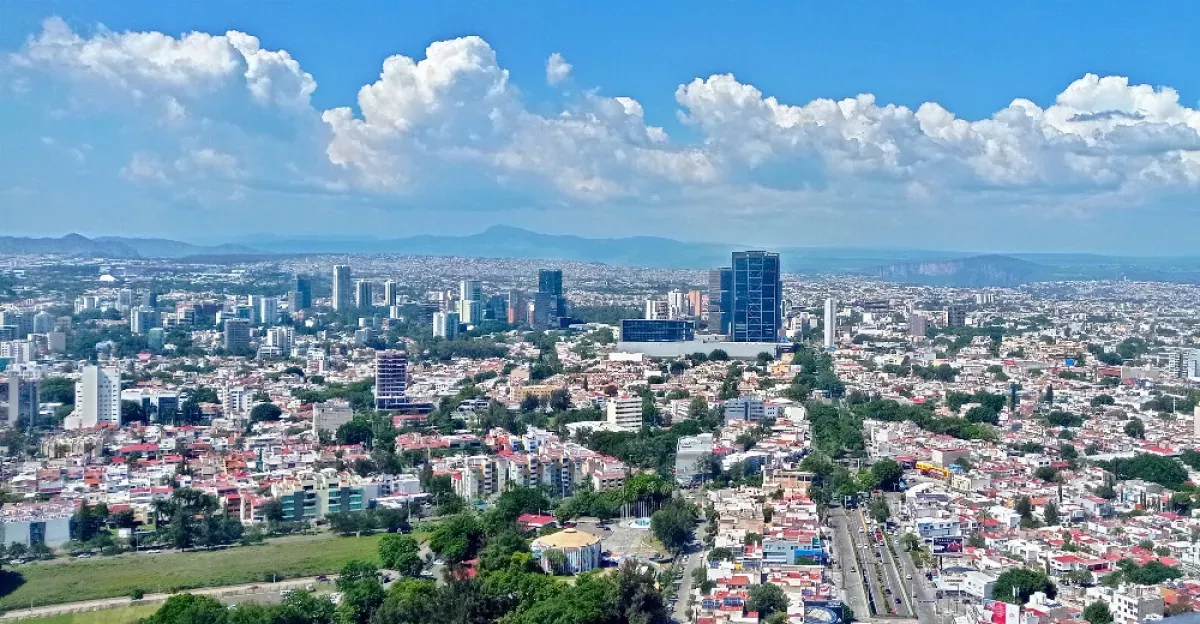Guadalajara, the capital of Jalisco in western Mexico, is a vibrant cultural and economic hub. With a population of 1,385,629, it's Mexico's 8th largest city. The Guadalajara metropolitan area, encompassing 5,268,642 people, ranks as the country's third-largest and the Americas' 22nd largest. Known for its high population density, Guadalajara thrives as a center for business, arts, culture, technology, and tourism, leading the Bajío region economically. The city is also celebrated for its architectural gems, including the Guadalajara Cathedral, Teatro Degollado, Templo Expiatorio, the UNESCO-listed Hospicio Cabañas, and the vast San Juan de Dios Market.
1907: Mariachi Music and Guadalajara
In 1907, an eight-piece mariachi band from Guadalajara performed for the Mexican president and the US Secretary of State, establishing the city's connection to the music.
1910: Mexican Revolution
Following the Mexican Revolution of 1910, Guadalajara became the second most populous city in Mexico. However, the revolution also led to regional wars and economic hardship, including the aftermath of the Great Depression.
1911: End of the Porfiriato
The Porfiriato, a period of economic growth and political stability under the rule of President Porfirio Díaz, came to an end in 1911 with the outbreak of the Mexican Revolution.
1914: End of Liceo de Varones
The Liceo de Varones, a school housed in the building that would become the Jalisco Regional Museum, operated until 1914.
1915: Orquesta Filarmónica de Jalisco Founded
The Orquesta Filarmónica de Jalisco was founded in Guadalajara in 1915 by José Rolón.
1918: Museum of Fine Arts Established
In 1918, the building now housing the Jalisco Regional Museum became the Museum of Fine Arts.
1920: End of the Mexican Revolution
The Mexican Revolution, a period of intense conflict and social change, came to an end in 1920, with the establishment of a new government.
1924: Orchestra Loses Funding
In 1924, the Orquesta Filarmónica de Jalisco lost state funding.
1925: Development of the University of Guadalajara
Founded in 1791, the University of Guadalajara's full development began in 1925, marking a significant milestone in its history and contribution to education.
1925: Modern University of Guadalajara Established
The modern University of Guadalajara was established in 1925.
1929: End of the Cristero War
The Cristero War, an uprising against the Mexican government's anti-clerical policies, ended in 1929 within Guadalajara, when President Plutarco Elías Calles issued the "Grito de Guadalajara", signifying a truce.
1935: Estudiantes Founded
The Estudiantes football team was founded in 1935.
1935: Universidad Autónoma de Guadalajara Founded
The Universidad Autónoma de Guadalajara (UAG), the oldest private university in Mexico, was founded in 1935.
1939: State Funding Reinstated
State funding for the Orquesta Filarmónica de Jalisco was reinstated in 1939.
1947: Establishment of the First Industrial Park
Guadalajara's first industrial park was established in 1947, signifying a period of industrial growth and transformation in the city.
1947: Start of José de Jesús González Gallo's term
The term of José de Jesús González Gallo as the governor of Guadalajara began in 1947, during which significant public works projects transformed the urban landscape of the city's historical center.
1950: Conciertos Guadalajara A. C. Formed
Conciertos Guadalajara A. C. was formed in 1950 to raise funds for the Orquesta Filarmónica de Jalisco.
1951: Atlas Wins Championship
The Atlas football team won its first championship in 1951.
1952: Jalisco Famous People Roundabout Constructed
The Jalisco Famous People Roundabout, a monument honoring distinguished individuals from Jalisco, was erected in 1952.
1953: End of José de Jesús González Gallo's term
José de Jesús González Gallo's term as governor concluded in 1953, marking the end of a period characterized by substantial urban development in Guadalajara.
1964: Population Surpasses One Million
Guadalajara's population exceeded one million in 1964, marking a significant demographic milestone in its growth.
1966: Guadalajara International Airport Opens
The Guadalajara International Airport, also known as Guadalajara International Airport (ICAO code: MMGL) opened in 1966. It was built in the city of Tlajomulco, near Chapala, and is located 16 km (10 mi) south of downtown Guadalajara.
1969: Chivas' Previous Double
Chivas previously won a Double in the 1969-1970 season.
1970: FIFA World Cup
Guadalajara hosted the FIFA World Cup in 1970, showcasing its ability to host major international sporting events.
1971: Orchestra Affiliated with Department of Fine Arts
The Orquesta Filarmónica de Jalisco became affiliated with the Department of Fine Arts of the State of Jalisco in 1971.
1976: Jalisco Regional Museum Inauguration
The Jalisco Regional Museum, housed in a former seminary and art museum, was remodeled and opened in its present form in 1976.
1980: Rapid Urbanization and Population Growth
Between the 1940s and 1980s, Guadalajara underwent significant urbanization, with its population doubling every decade until reaching 2.5 million in 1980. However, from the early 1990s, the municipality's population plateaued and began to decline.
1982: Legislative Palace Reconstruction
The Legislative Palace in Guadalajara, originally an 18th-century structure, underwent reconstruction in 1982.
1986: FIFA World Cup
Guadalajara once again hosted the FIFA World Cup in 1986, further cementing its reputation as a prominent sporting venue.
1987: Expo Guadalajara Construction
The Expo Guadalajara, a major convention center in Mexico, was built in 1987.
1988: Festival Cultural de Mayo Inauguration
The Festival Cultural de Mayo, a significant cultural event in Guadalajara, was first held in 1988.
1988: Orchestra's Current Name Adopted
The Orquesta Filarmónica de Jalisco adopted its current name in 1988.
1990: Socioeconomic Improvements and Disparities
Between 1990 and 2000, Guadalajara saw improvements in quality of life indicators, though a significant gap persisted between the rich and the poor.
1990: Growth Tied to Foreign Investment
From 1990 onward, Guadalajara experienced significant economic growth largely driven by foreign investment, particularly in manufacturing for export to the United States and the domestic Mexican market.
1991: First Cumbre Iberoamericana
Guadalajara hosted the inaugural Cumbre Iberoamericana in 1991, marking its significance as a venue for international events.
1991: 1st Ibero-American Summit
Guadalajara hosted the inaugural Ibero-American Summit in 1991, highlighting its role as a center for international diplomacy and cooperation.
April 22, 1992: Guadalajara Explosions
On April 22, 1992, a series of gasoline explosions in the sewer system devastated Guadalajara's downtown Analco district. The explosions, which occurred over four hours, destroyed 8 kilometers of streets, resulting in 206 deaths, nearly 500 injuries, and 15,000 people left homeless. The estimated cost of the damage ranged from $300 million to $1 billion.
1993: Murder of Cardinal Juan Jesús Posadas Ocampo
The assassination of Cardinal Juan Jesús Posadas Ocampo in 1993 marked a period of turmoil and violence in Guadalajara during the 1990s.
1994: Estudiantes Wins Championship
The Estudiantes football team won a championship in 1994.
1994: Festival of Mariachi and Charreria
The Festival of Mariachi and Charreria began in Guadalajara in 1994, featuring top mariachi bands from Mexico and around the world.
1994: Mexican peso crisis
The Mexican peso crisis of 1994, coupled with the devastating explosions of 1992, led to a significant decline in Guadalajara's industrial strength.
1995: Exports Growth Begins
Guadalajara's exports experienced significant growth, starting at US$3.92 billion in 1995.
1996: Influence of Multinational Corporations
Since 1996, the presence of multinational corporations like Kodak, Hewlett-Packard, Motorola, and IBM significantly impacted Guadalajara's economic and social landscape. These companies established production facilities outside the city, attracting foreign investment and labor. This led to a shift from manufacturing to a service-based economy, driven by technology and foreign investment.
June 5, 1997: Protected Natural Area designation
On June 5, 1997, the canyon in Guadalajara was declared a Protected Natural Area, specifically an Area Subject to Ecological Conservation (Zona Sujeta a Conservación Ecológica), due to its rich biodiversity and ecological importance.
December 1997: Rare snowfall
December 1997 witnessed an extraordinarily rare snowfall in Guadalajara, the first in 116 years, breaking a record set in 1881.
1997: Hospicio Cabañas Becomes World Heritage Site
The Former Hospice Cabañas, known for its murals by José Clemente Orozco, was designated a UNESCO World Heritage Site in 1997.
2000: End of Socioeconomic Study Period
The study on socioeconomic indicators and their changes in Guadalajara concluded in 2000, revealing improvements with persistent disparities.
2003: Exports Reach US$14.3 Billion
By 2003, Guadalajara's exports had reached US$14.3 billion, demonstrating substantial growth.
2004: Third Summit of Heads of State and Governments of Latin America, the Caribbean, and the European Union
Guadalajara hosted the Third Summit of Heads of State and Governments of Latin America, the Caribbean, and the European Union in 2004, further solidifying its role as a hub for international diplomacy.
2005: Austria as Guest of Honor
Austria was the featured country at the 2005 Festival Cultural de Mayo.
2005: American Capital of Culture
Guadalajara was designated as the American Capital of Culture in 2005, recognizing its vibrant cultural scene and contributions to the arts.
2005: Encuentro Internacional de Promotores y Gestores Culturales and American Capital of Culture
In 2005, Guadalajara hosted the Encuentro Internacional de Promotores y Gestores Culturales and was designated as the American Capital of Culture, highlighting its cultural significance.
2006: Ciudad Educadora
Guadalajara was recognized as the "Ciudad Educadora" in 2006, highlighting its commitment to education and innovation.
2006: Rise of Indian IT in Guadalajara
The trend of Indian IT companies establishing a presence in Guadalajara began after 2006, attracted by government incentives and the city's strategic location.
2007: FDi magazine "Cities of the Future" survey
FDi magazine's "Cities of the Future" survey in 2007 ranked Guadalajara as a leading city for economic potential. It was recognized as having the second strongest potential among major North American cities, trailing only Chicago, and was also named the most business-friendly city in Latin America.
2007: FDi magazine rankings
In 2007, FDi magazine recognized Guadalajara's economic potential, ranking it first among major Mexican cities and second among major North American cities, trailing only Chicago. It also highlighted Guadalajara as the most business-friendly city in Latin America.
2007: United Nations list of most populous urban agglomerations
In 2007, the United Nations recognized Guadalajara as the 66th most populous urban agglomeration globally, highlighting its position as a major urban center.
2007: Mexico as Guest of Honor
Mexico was the featured country at the 2007 Festival Cultural de Mayo.
2007: Previous Mariachi World Record
The previous record for largest mariachi group was set in 2007 in San Antonio, Texas.
2008: Germany as Guest of Honor
Germany was the "guest of honor" at the 2008 Festival Cultural de Mayo.
2008: Opening of the Andares commercial center
The Andares commercial center, a $530 million mixed-use complex designed by the renowned Mexican Sordo Madaleno architecture firm, opened in Zapopan in 2008. Featuring luxury residences, a high-end mall anchored by Liverpool and El Palacio de Hierro department stores, and a wide array of shops and restaurants, Andares has become a significant commercial hub.
2008: Guadalajara Metropolitan Area Population
The Guadalajara Metropolitan Area had a population of 4,298,715 in 2008.
August 2009: World Record Mariachi Performance
In August 2009, Guadalajara broke the world record for the largest mariachi group with 542 musicians performing together.
2009: Competition with China and shift towards high-value services
In 2009, Guadalajara faced increasing competition from China, particularly in the electronics industry. As a result, the city strategically shifted its focus towards high-mix, mid-volume, and value-added services, leveraging its proximity to the U.S. market as a competitive advantage.
2009: Moody's Investors Service ratings
Moody's Investors Service assigned Guadalajara ratings of Ba1 (Global Scale, local currency) and A1.mx (Mexican national scale) in 2009, acknowledging the city's stabilizing financial performance and robust budget.
2009: Phase I of Guadalajara Macrobús Opens
Phase I of the Guadalajara Macrobús, a bus rapid transit system, opened in 2009. The initial phase featured a 16-kilometer-long (9.9 mi) corridor following Calzada Independencia and serving 27 stations.
2009: Notable Figures at Book Fair
The 2009 Guadalajara International Book Fair hosted prominent authors like Orhan Pamuk, Cornelia Funke, and Mario Vargas Llosa.
2009: International Film Festival Expands
The 2009 International Film Festival of Guadalajara showcased over 200 films across 16 venues, including open-air screenings.
2010: Population census by INEGI
The National Institute of Statistics and Geography (INEGI) conducted a population census in 2010, confirming Guadalajara's population to be approximately 1,495,189, making it the most populous city in Jalisco and the second most populous in Mexico.
2011: Pan American Games
Guadalajara hosted the Pan American Games in 2011, demonstrating its capability in organizing large-scale multi-sport events.
2011: Guadalajara Hosts Pan American Games
Guadalajara hosted the Pan American Games in 2011, leading to extensive city renovations and infrastructure improvements.
2011: Renovation of Plaza de los Mariachis
Guadalajara's Plaza de los Mariachis was renovated in 2011 in preparation for the Pan American Games.
2012: University of Guadalajara Ranking
The University of Guadalajara was ranked fifth among the best Mexican universities in 2012.
October 2013: Indian IT Companies in Guadalajara
By October 2013, five major Indian IT companies had set up offices in Guadalajara, taking advantage of Mexico's affordability and access to the US market. This trend emerged after 2006.
2013: France as Guest of Honor
France was the "guest of honor" at the 2013 Festival Cultural de Mayo.
2013: IEEE "Smart City" designation
Guadalajara received the prestigious "Smart City" designation from IEEE, the world's largest professional association for the advancement of technology, in 2013, recognizing its innovative use of technology.
2013: Formation of the first "Cluster Smart Cities"
In early March 2013, Guadalajara joined Dublin, Ireland; San Jose, California; and Cardiff, Wales, to form the world's first "Cluster Smart Cities," aiming to share knowledge and best practices in areas such as agribusiness and health sciences.
May 2014: Estudiantes Relocates
In May 2014, the Estudiantes football team moved to Zacatecas and became Mineros de Zacatecas.
October 2014: Charros de Jalisco Franchise Returns
The Charros de Jalisco baseball franchise returned to Guadalajara in October 2014.
2014: Construction Begins on SITEUR Line 3
Construction on the third line of the Guadalajara light rail system, SITEUR, began in 2014. Line 3 was designed to run from Zapopan, in the northwest, to Tlaquepaque and Tonalá, in the southeast, via the city center.
2014: Mi Bici Pública Launches
Guadalajara launched its public bike share system, Mi Bici Pública, based on PBSC Urban Solutions, in 2014.
October 2015: Smart Cities Initiative conference
Guadalajara hosted the inaugural conference of the Smart Cities Initiative from October 25th to 28th, 2015, further solidifying its reputation as a leader in urban innovation and technology.
2016: Mi Bici Pública Expands
In 2016, Guadalajara's public bike share system, Mi Bici Pública, expanded to include 242 docking stations and 2116 bikes.
2017: Chivas Wins Double
In 2017, the Chivas football team became the first in Mexican history to win a Double (league and cup titles) twice in a single season.
September 2018: Mi Bici Pública Reaches 19,664 Annual Subscribers
By September 2018, Mi Bici Pública, the PBSC Urban Solutions-based public bike share system launched in 2014, reached 19,664 annually subscribed users.
2018: Chivas Wins CONCACAF Champions League
Chivas won the CONCACAF Champions League final in 2018.
2020: SITEUR Line 3 Completed
Construction on Line 3 of the SITEUR light rail system in Guadalajara concluded in 2020, connecting Zapopan in the northwest to Tlaquepaque and Tonalá in the southeast.
2021: Guadalajara Hosts WTA Finals
Guadalajara hosted the WTA Finals in 2021, marking the tournament's first time in Latin America.
2021: Atlas Wins First Division Championship
The Atlas football team won the first division championship in 2021.
2022: Guadalajara as World Book Capital
Guadalajara was designated as the World Book Capital in 2022 by UNESCO.
2026: Guadalajara to Host FIFA World Cup Matches
Guadalajara will be one of the host cities for the 2026 FIFA World Cup.
Mentioned in this timeline

Liverpool is a port city and metropolitan borough located in...
California is a U S state on the Pacific Coast...
Germany officially the Federal Republic of Germany is a Western...
China officially the People's Republic of China PRC is an...
Japan is an East Asian island country situated in the...

Football is a family of team sports primarily involving kicking...
Trending
Byrum Brown is an American college football quarterback currently playing for the South Florida Bulls His primary role is as...

Barry Manilow is a celebrated American singer-songwriter whose career has thrived for six decades He is renowned for his hit...

2 months ago Rahm Emanuel Considers 2028 Presidential Bid, Citing Record and Republican Trust.
1 month ago Fidelity & Schwab Crackdown: Credential Sharing Concerns and Security Measures Implemented.

Robert Patrick Petrino is a well-known figure in American college football coaching He currently serves as the offensive coordinator and...

1 month ago Benny Safdie as Bowser Jr. in Super Mario Galaxy Movie Trailer
Popular

Candace Owens is an American conservative political commentator and author...

Tucker Carlson is an American conservative political commentator known for...

XXXTentacion born Jahseh Dwayne Ricardo Onfroy was a controversial yet...

Ben Shapiro is a prominent American conservative political commentator media...

William Franklin Graham III commonly known as Franklin Graham is...

Bill Gates an American businessman and philanthropist revolutionized personal computing...
